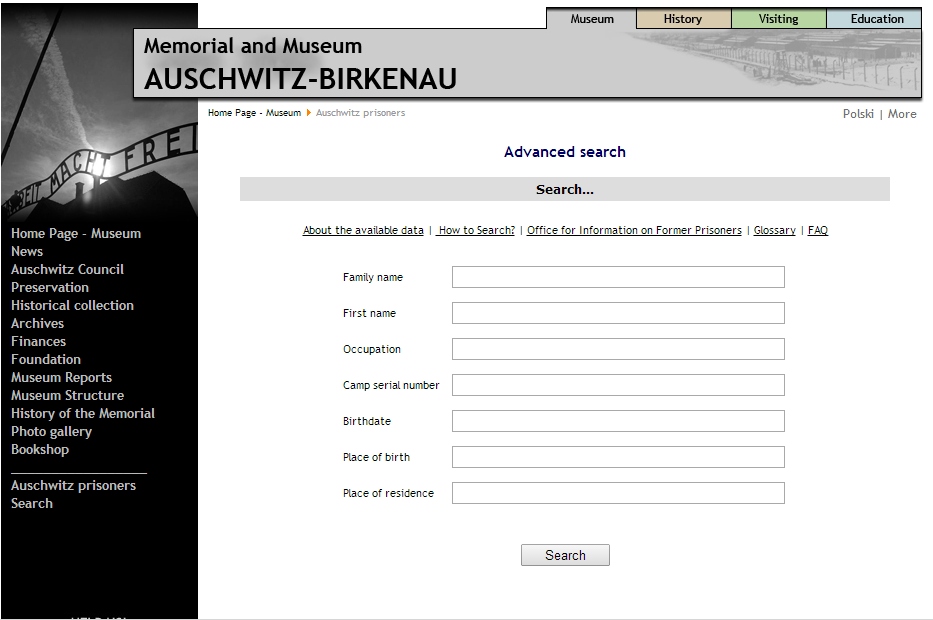
Gertrude & Sonia Preiss-Spiro’s names are listed on the transport to Auschwitz of 141 women from Pawiak prison in Warsaw on 24 August 1943. Pawiak prison was originally used by the Polish judicial to incarcerate criminals, but after the Nazi invasion of Poland in 1939, it was converted into a German Gestapo prison. Approximately 100,000 men and 200,000 women passed through the prison, mostly members of the Armia Krajowa, political prisoners and civilians taken as hostages in street round-ups. An estimate 37, 000 were executed and 60,000 sent to German death and concentration camps. There were few known escape attempts.
Even if Gertrude survived Auschwitz, she would undoubtedly be dead by now, considering she was about the same age as her friend Charlotte Rebhun who was born in 1908. There is a slim chance her daughter Sonia would still be alive, although she would probably be in her late-80s.

Hoping to find for more information on Gertrude and Sonia’s fate in Auschwitz, I searched the Auschwitz prisoner database for them by name, but nothing came up. This was not surprising, as many Auschwitz records were destroyed by the Nazis in the final days before the camp was liberated.
According to the website Więźniów Pawiaka and Danuta Czech’s Auschwitz Chronicles, the 141 women on the transport were assigned numbers 55778 – 55918. Curious about whether I could find information on any of the women on the transport, I searched it by number and was surprised to discover that many of the women were listed, and that they were assigned numbers in more or less alphabetical order. The first number #55778 was assigned to Anaszkiewicz, Marianna; the last number #55918 was assigned to Zielińska, Zofia. (This was slightly out of order since the last woman alphabetically Złotnicka, Irena was given #55907).
The list yielded valuable information about Gertrude and Sonia, but what I found was was quite different from what I expected. I was stunned to discover that although there were 141 numbers reserved for the group, there were only 138 women who were assigned these numbers. Three women were missing from the list, including Gertrude and Sonia Preiss-Spiro. Considering the Auschwitz Chronicles do not mention any deaths while the transport was en route, nor any executions that took place upon arrival, I concluded that Gertrude and Sonia were not on the transport. Although they were included on the “passenger” manifest, they probably did not board the train. There was no further information on the third missing woman, Elizabeth Rudnik.

Two of the most valued commodities during wartime are liquor and tobacco. According to Barbara Engelking’s book The Warsaw Ghetto, in March 1942, a few months before the major transport from the Ghetto to Treblinka, a pack of cigarettes cost about 0.4 zlotys. In September 1942, as the situation in the Ghetto worsened, a cigarette cost 3 zlotys. By May 1943, a cigarette cost 250 zlotys. The price of liquor also skyrocketed.
Until she was arrested, probably in the spring or summer of 1943, Gertrude Spiro owned a liquor and cigarette shop at Nowiniarska St. No. 2 on the Aryan side of Warsaw. She must have accumulated much wealth through her shop, and was likely active in the Black Market. She would have made many of the right contacts among the higher-ups in Warsaw, who probably depended on her to maintain their stock of liquor and cigarettes. She would have had the money and the connections to save herself and her daughter from being transported to Auschwitz.
My guess is that when the transport arrived at the camp, the person assigning the numbers realized that three prisoners were missing. Knowing that he might be executed for the shortage, he simply skipped three numbers as he went down the list, making sure that the first number was assigned to the first woman on the list, and the last number to the last woman. No one noticed.
Gertrude and Sonia probably bribed their way off the transport and went into hiding in Warsaw.
Nothing more is known of their fate. A search of the Yad Vashem, Karta, the Memorial Book on the website of the Bundesarchiv in Berlin has yielded no further information. We continue to search, hoping that if Gertrude and Sonia survived, they may have left behind some information about the baby they helped smuggle from the Warsaw Ghetto in the fall of 1942.
To be continued…
Part I: Who Am I? What is My Name? Pnina, Otwoc, and the Kaczmareks
Part II: Who Am I? What is My Name? Pnina, Wolfgang, and the Warsaw Ghetto
Part III: Who Am I? What is My Name? Gertrude and Sonia Spyra
Part IV – Who Am I, What is My Name? Wolfgang & Adele’s Eyewitness Account
Part V – Who Am I, What is My Name? Gertrude and Sonia’s Escape
Part VI – Who Am I, What is My Name? Our Search for Gertrude Spiro
Part VII – Who Am I? What is My Name? Gertrude’s Other Children?
Part VIII – Who Am I? What is My Name? Gertrud and Leo’s Trial
Part IX – Who Am I? What is My Name? Gertrude’s Sisters!
Part X: Who Am I? What is My Name? Gertrude’s Marriage and Divorce
Part XI: Who Am I? What is My Name? Berlin, Warsaw, and the German Soldier

5 Responses